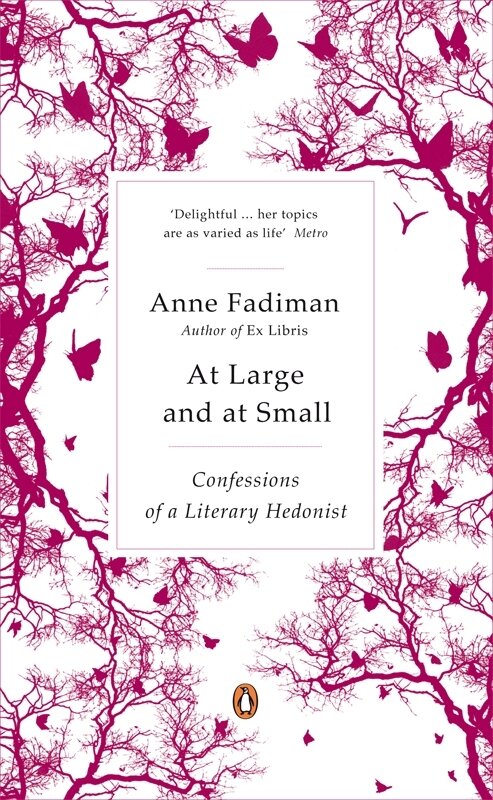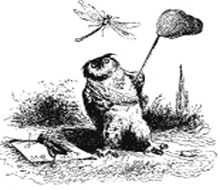At Large and At Small
Read At Large and At Small Online
Authors: Anne Fadiman

A
T
L
ARGE
AND
A
T
S
MALL
A
LSO BY
A
NNE
F
ADIMAN
The Spirit Catches You and You Fall Down
Ex Libris
E
DITED BY
A
NNE
F
ADIMAN
The Best American Essays 2003
Rereadings
T
L
A R G E
A N D AT S M A L L
C
O N F E S S I O N S O F A
L
I T E R A R Y
H
E D O N I S T

A
N N E
F
A D I M A N
ALLEN LANE
an imprint of
PENGUIN BOOK
ALLEN LANE
Published by the Penguin Group
Penguin Books Ltd, 80 Strand, London WC2R 0RL, England
Penguin Group (USA) Inc., 375 Hudson Street, New York, New York 10014, USA
Penguin Group (Canada), 90 Eglinton Avenue East, Suite 700, Toronto, Ontario, Canada m4p 2y3
(a division of Pearson Penguin Canada Inc.)
Penguin Ireland, 25
St Stephen’s Green, Dublin 2, Ireland (a division of Penguin Books Ltd)
Penguin Group (Australia), 250 Camberwell Road, Camberwell, Victoria 3124, Australia
(a division of Pearson Australia Group Pty Ltd)
Penguin Books India Pvt Ltd, 11 Community Centre,
Panchsheel Park, New Delhi – 110 017, India
Penguin Group (NZ), 67 Apollo Drive, Rosedale, North Shore 0632, New Zealand
(a division of Pearson
New Zealand Ltd)
Penguin Books (South Africa) (Pty) Ltd, 24 Sturdee Avenue,
Rosebank, Johannesburg 2196, South Africa
Penguin Books Ltd, Registered Offices: 80 Strand, London WC2R 0RL, England
First published in the United States of America by Farrar, Straus and Giroux 2007
First published in Great Britain by Allen Lane 2007
1
Copyright © Anne Fadiman, 2007
The moral right
of the author has been asserted
With the exception of “Under Water,” an earlier version of which appeared in
The New Yorker
, the essays
in this book appeared, in somewhat different form, in
The American Scholar
Endpapers: Plate 79, “Insects of the Orders Hymenoptera, Diptera, Lepidoptera, and Odonata,”
engraving by Henry Winkles after J. G. Heck,
from J. G. Heck,
Iconographic Encyclopedia of
Science, Literature, and Art
(New York: Rudolph Garrigue, 1851).
All rights reserved
Without limiting the rights under copyright
reserved above, no part of this publication may be
reproduced, stored in or introduced into a retrieval system,
or transmitted, in any form or by any means (electronic, mechanical,
photocopying, recording or otherwise), without the prior
written permission of both the
copyright owner and
the above publisher of this book
A CIP catalogue record for this book is available from the British Library
eISBN: 978–0–141–90369–9
F
OR
K
IM
Collector of Tiger Swallowtails
,
Emperor of Ice Cream
ONTENTS
P
REFACE
 ust over half a century ago, in “A Gentle Dirge for the Familiar Essay,” a dispirited writer mourned the imminent death of a genre that was “setting to the horizon, along with its whole constellation: formal manners, apt quotation, Greek and Latin, clear speech, conversation, the gentleman’s
ust over half a century ago, in “A Gentle Dirge for the Familiar Essay,” a dispirited writer mourned the imminent death of a genre that was “setting to the horizon, along with its whole constellation: formal manners, apt quotation, Greek and Latin, clear speech, conversation, the gentleman’s
library, the gentleman’s income, the gentleman.”
The writer was my father, Clifton Fadiman, who— accompanied by his mailbox, his wastebasket, and his insomnia—makes cameo appearances in several of the essays in this book. “A Gentle Dirge for the Familiar Essay”
is
a familiar essay, and it therefore vibrates with a Chinese- box- like meta- ness. Its own excellence fights against its message.
The essay portending the end of the essay has become a genre in itself, one whose persistence suggests that the previous soothsayers may have been wrong and the current ones may therefore be wrong as well. Although most of the items on my father’s valedictory list have crept
even farther toward the horizon, the most important among them is still in full view. I refer, of course, to conversation,
a taste I acquired, along with a fondness for pungent curries and moldering Stilton, at the Fadiman dinner table. Conversation was at the center of my father’s life, it’s at the center of mine, and it’s at the center of the familiar essay.
“Familiar essay” isn’t a term one hears often these days. The genre’s heyday was the early nineteenth century, when Charles Lamb was dreaming up
The Essays
of Elia
under the influence of brandy and tobacco and William Hazlitt was dashing off
Table- Talk
under the influence of strong tea. The familiar essayist didn’t speak to the millions; he spoke to
one
reader, as if the two of them were sitting side by side in front of a crackling fire with their cravats loosened, their favorite stimulants at hand, and a long evening of conversation stretching
before them. His viewpoint was subjective, his frame of reference concrete, his style digressive, his eccentricities conspicuous, and his laughter usually at his own expense. And though he wrote about himself, he also wrote about a
subject
, something with which he was so familiar, and about which he was often so enthusiastic, that his words were suffused with a lover’s intimacy. Hence the profusion
of titles beginning with the word “On”: “On the Melancholy of Tailors,” “On the Feeling of Immortality in Youth,” “On the Danger of Confounding Moral with Personal Deformity,” “On the Conversation of Authors,” “On the Genius and Character of Hogarth,” “On the Inconveniences Resulting from Being Hanged,” “On the
Custom of Hissing at the Theatres,” “On the Love of Life,” “On Gusto.” On gusto! The
familiar essay in a nutshell!
Today’s readers encounter plenty of critical essays (more brain than heart) and plenty of personal—very personal—essays (more heart than brain), but not many familiar essays (equal measures of both). If I were to turn Lamb’s 1821 “Chapter on Ears” into a twenty- first-century critical essay, I might write about postmodern audiological imagery in the early works of
Barbara Cart-land. If I were to write a twenty- first- century personal essay, I might tell you about the pimple on my left earlobe that I failed to cover with makeup at my senior prom, about that ear thing my college boyfriend did with his tongue (how did he get it so
pointy
?), and about the countless times I courted deafness by turning up “Jumpin’ Jack Flash” to max volume. But I don’t want
to write—or read—either of those essays. I prefer Lamb’s original, which is mostly about his musical ineptitude but also about the sounds of harpsichords, pianos, operatic voices, crowded streets, and carpenter’s hammers: in other words, about the author but also about the world.
I believe the survival of the familiar essay is worth fighting for. This little volume is my contribution to the war
effort, both a declaration of my esteem—no, my love—for the genre and an expression of my own character, a blend of narcissism and curiosity that is inconvenient in many contexts but perhaps oddly suited to this one. Its dozen essays took shape over the course of seven years, beginning in 1998, and, aside from the last one, they
are presented in the order in which they were written. Some were
prompted by events in my life (learning to use e- mail, moving from the city to the country), some by events in the larger world (the Culture Wars, which I wrote about while their casualties were still mounting; America’s rediscovery of its flag, which I wrote about three months after 9/11). I’ve left the time- anchored vantage points unchanged. Several of the essays were written under the influence,
though not of brandy, tobacco, or tea. I ingested a shocking amount of Häagen- Dazs while I wrote about ice cream. I sustained a terrific caffeine buzz while I wrote about coffee. I wrote every word of the night- owl essay between midnight and dawn. Three essays were composed under the influence of great men: Vilhjalmur Stefansson, Samuel Taylor Coleridge, and— closest to my heart—Charles Lamb,
whose shade watched over me, I liked to think, as I sat at my desk and addressed the kind of reader with whom he used to converse himself.
The title is meant to suggest that my interests are presbyopic (“at large”) but my focus is myopic (“at small”). While I was working on this book, I came across “On Great and Little Things,” an essay by Hazlitt. “The organs of the mind, like the pupil of the
eye, may be contracted or dilated to view a broader or narrower surface,” he wrote, “and yet find sufficient variety to occupy its attention in each.” I feel that way too.
Unlike my father, I do not believe that the ability to write a familiar essay depends on whether one’s manners are formal (mine aren’t), one knows Greek and Latin
(I’ve forgotten the little I once knew), or one is a gentleman
(I most assuredly am not). If a psychologist were to analyze my attachment to the genre, he might zero in on another Clifton Fadiman passage, one that observes that few women write familiar essays because “the form does not attract them.” Well, it attracts
me
. And I hope that it will continue to attract enough other writers—and readers—that no dirge, gentle or otherwise, need ever be sung to lament
its passing.
A.F.
T
L
ARGE
AND AT SMALL
C
OLLECTING
N
ATURE
 he net was green. The handle was wood, and the grip was uncomfortably thick, like that of a tennis racket borrowed from an older player. The mesh bag was long enough that if we caught a tiger swallowtail—or a spicebush swallowtail, or a mourning cloak, or a
he net was green. The handle was wood, and the grip was uncomfortably thick, like that of a tennis racket borrowed from an older player. The mesh bag was long enough that if we caught a tiger swallowtail—or a spicebush swallowtail, or a mourning cloak, or a
European cabbage, or a common sulphur, or a red admiral, or a painted lady, or a monarch, or a viceroy—we could, with a twist of the wrist, flip its tapered tip over the wire rim and trap the butterfly inside.